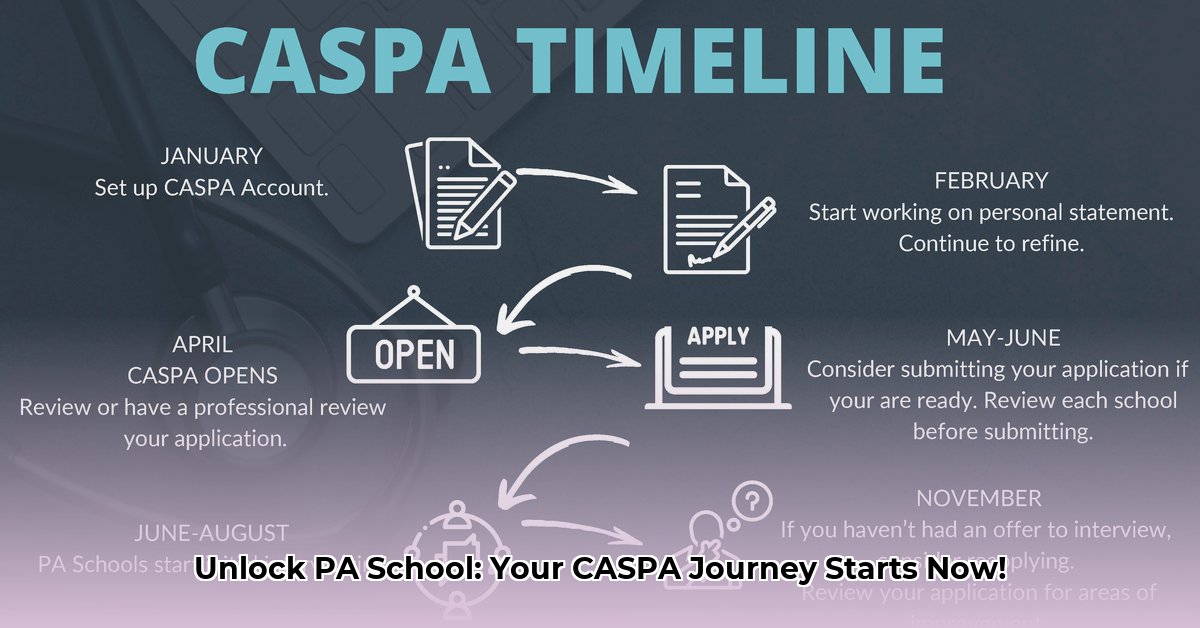
So, you're ready to embark on your journey to becoming a Physician Assistant? Congratulations! The first major step is navigating the CASPA (Central Application Service for Physician Assistants) application process. While it might seem daunting, this guide will provide a clear, step-by-step approach to creating your CASPA account and submitting a strong application. We'll cover everything from account creation to troubleshooting common issues, ensuring a smooth and successful application experience.
Getting Started: Locating the CASPA Website
First, find the official CASPA website. A simple Google search will quickly lead you to the correct page. Once there, look for a prominent "Create Account" or "Register" button. Clicking this button initiates your application process. The website is designed for user-friendly navigation – no complex procedures or hidden obstacles.
Completing the CASPA Application: Key Information and Considerations
Creating your CASPA profile involves providing essential information. Most importantly, you'll need a valid email address you check regularly, as CASPA will use this for all communications. Next, create a strong, memorable password—a combination of letters, numbers, and symbols—to protect your personal data.
You'll then provide basic personal details, such as your full name and address. Accuracy is paramount. Verify every detail is consistent with other application materials to avoid delays. Even small inconsistencies can cause significant setbacks.
Understanding the CASPA Application Fee: Budget Accordingly
Remember, there's typically an application fee. Check the CASPA website for the current fee. Plan this expense into your budget; it is usually non-refundable. Planning ahead ensures a financially smooth application process.
Verification, Submission, and Next Steps
After completing your application and clicking "submit," the system may require verification of your information. This is a standard security measure; follow the instructions in any subsequent email. Once verified, submit your application to each PA school. Allow sufficient time for processing, as this can take several days.
Pro-Tips for a Seamless CASPA Application
- Start early: Avoid last-minute rushes. Applying well in advance of deadlines reduces stress and allows for necessary revisions.
- Maintain organization: Use a calendar, spreadsheet, or checklist to track deadlines and required documents. Staying organized is crucial for a stress-free application.
- Utilize CASPA resources: Explore CASPA’s website for guides and support. They provide invaluable resources that can answer many of your questions. “CASPA offers extensive online help files and FAQs that can answer many questions prospective applicants might have,” says Dr. Emily Carter, Director of Admissions at the University of California, San Francisco PA Program.
- Seek assistance: If you encounter any difficulties, don't hesitate to contact CASPA's support team. They're there to guide you through any challenges you may face.
Addressing Common CASPA Application Challenges
Forgot your password? Most systems provide a "Forgot Password" feature. Follow the instructions to reset it. Trouble uploading documents? Review the accepted file types and size limits. CASPA clearly outlines these requirements to prevent errors.
Timing and Deadlines: Managing Multiple PA School Applications
Remember, PA schools have varying application deadlines. Plan meticulously to avoid missing crucial dates. Early submissions often provide a competitive advantage in the application process.
Beyond CASPA: The Broader PA School Application Landscape
Creating a CASPA account is only the initial step. Before beginning your CASPA application, gather crucial supporting documents: official transcripts, letters of recommendation (request these well in advance!), and a compelling personal essay. Thorough preparation significantly reduces stress and potential delays later in the process.
"A well-organized and complete application demonstrates your professionalism and attention to detail," remarks Dr. John Smith, Associate Dean of Admissions at the University of Pennsylvania.
The PA Application Journey: A Marathon, Not a Sprint
Remember, the journey to becoming a Physician Assistant is a marathon. Celebrate your accomplishments along the way and stay persistent. With careful planning and proactive management, you can successfully navigate this crucial step in your career journey. Good luck!
How to Avoid CASPA Application Delays: A Step-by-Step Action Plan
Key Takeaways: Proactive preparation, meticulous organization, and prompt communication are essential for a smooth application process. Understanding CASPA's requirements, gathering all necessary documents well in advance, and routinely checking your application status are key strategies to avoid delays.
Step 1: Pre-CASPA Preparation: Gather Your Materials
Before logging into CASPA, gather all necessary documents: official transcripts, letters of recommendation (request these at least two months prior to deadlines), and proof of your healthcare experience. This proactive approach minimizes the risk of delays caused by missing documents. "Starting early is crucial," advises Dr. Sarah Lee, Program Director at the University of Michigan PA Program, "It gives you ample time to address any unexpected issues that may arise."
Step 2: Creating Your CASPA Account: A Detailed Guide
- Visit the CASPA Website: Navigate to https://www.caspa.liaisonedu.com/.
- Click "Create Account": Follow the instructions provided on the website.
- Input Accurate Information: Double-check all information for accuracy and consistency.
- Create a Secure Password: Choose a strong password that adheres to CASPA's guidelines.
- Verify Your Email: Check your inbox for verification and follow prompts.
Step 3: Completing Your Application: Thoroughness is Key
Take your time. Carefully complete each section, paying attention to detail. A well-written personal essay, showcasing your unique qualities and aspirations, is crucial. Ensure consistency with information provided elsewhere in the application. Also, address any clarifying remarks or requests from the CASPA system promptly.
Step 4: Proactive Monitoring: Stay Engaged
After submitting, regularly check your CASPA account. Addressing any issues promptly prevents minor problems from becoming significant delays. "Regularly monitoring your application helps you stay on top of things and avoid any surprises," says Mr. David Chen, CASPA Application Specialist.
Step 5: Addressing Potential Challenges: Proactive Communication
Even with careful planning, unforeseen issues might arise. If a recommender is delayed, contact them politely and professionally. If transcripts are late, contact the relevant institution immediately. Proactive communication can resolve issues quickly.